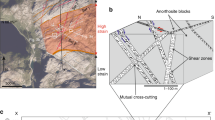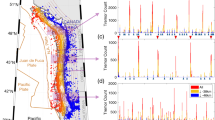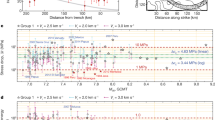Abstract
Slow earthquakes that occur at subduction zones are distinct from regular earthquakes in terms of their slip behavior. We consider this difference to relate to localized hydration reactions at the plate interface that influence the frictional properties. The results of laboratory friction experiments indicate that simulated serpentine faults are characterized by a low healing rate and large slip-weakening distance compared with unaltered dry fault patches. These results are consistent with the slip mechanism of slow earthquakes, indicating that a locally serpentinized plate interface could trigger slow earthquakes, assisted by pore pressure build-up, whereas unaltered dry patches that remain strongly coupled are potential sites of regular earthquakes.
Similar content being viewed by others
Introduction
Slow earthquakes that occur at the subducting plate interface, including low-frequency tremors and slow-slip events, are distinct from regular earthquakes in terms of their slip behavior1. The occurrence of these events is attributed to the presence of aqueous fluids on the plate interface, since low seismic-wave velocities and high Poisson's ratios are commonly detected in the source regions2,3,4. Accordingly, it has been widely accepted that fluids make an important contribution to the generation of slow earthquakes due to their role in reducing the effective pressure5,6; however, the long characteristic duration and small release of radiation energy during such events cannot be explained by excess pore fluid pressure alone. Consequently, there must be difference in physical mechanism between slow and regular earthquakes7. Fluids released from the subducting slab infiltrate into the overlying mantle and in this case serpentine is expected to form by hydration reactions on the plate interface8. Spatial variations in frictional properties on the plate interface can arise from such heterogeneous mineral reactions.
Subduction zone earthquakes occur periodically due to the accumulation of stress/strain at the plate interface. Although a complex combination of mechanical and chemical processes plays a role in earthquake generation, frictional strengthening is likely to make a key contribution to the recovery of fault strength during the period between successive seismic events. Laboratory experiments have demonstrated that friction in stationary contact increases linearly with the logarithm of time9,10,11, as follows:

where μ0 is the friction at the beginning of stationary contact and b is the healing rate. The time-dependent healing of frictional strength is thought to be a result of thermally activated mechanisms that weld micro-size asperity contacts on the fault surface12. However, recent experiments have shown that clay minerals exhibit an extremely low healing rate that may promote aseismic creep13,14. Numerical simulations indicate that the slip-weakening distance, which is the transient distance from the peak friction to steady-state friction, is crucial for generating slow earthquakes, whereby a larger slip-distance is favorable for the generation of slow slip events15,16. Hydration at the subducting plate interface results in serpentinization and such area may differ from dry unaltered patches in terms of healing rate and slip-weakening distance, probably favoring the generation of slow earthquakes. In this study, we test this hypothesis by performing friction experiments of simulated serpentine faults.
Results
Two types of serpentine were prepared as a starting material: antigorite (a high-temperature polymorph) and lizardite/chrysotile (a low-temperature polymorph)17. Quartz and olivine were used separately as dry fault materials for comparison with the serpentine experiments. We carried out a series of slide–hold–slide friction experiments to examine the time-dependent frictional re-strengthening of the simulated fault gouge (Table S1). The experiment results show that the frictional coefficient increases with displacement and attains a steady-state level (Fig. 1). We began the slide–hold–slide tests after ~10 mm of displacement, to ensure that steady-state frictional behavior had been attained. The axial loading was then interrupted for periods ranging from 10 to 3000 s at displacement interval of 0.5 or 1.0 mm. We measured the frictional healing effect (Δμ) as the difference between the steady-state friction before each holding period and the peak friction after each holding period (Fig. 1). Figure 2 shows the experimental results of frictional healing Δμ in the simulated fault with different minerals. In the dry gouge materials, frictional healing shows a systematic increase with holding time, which is consistent with previous experiments9,10,11. Frictional healing in the serpentine gouges shows a slight increase with time for a short holding time, whereas peak friction is nearly constant or decreases with a longer holding time of >1000 s (Fig. 2). Similar results were obtained for different loading velocities (1 and 10 μm/s). Under wet conditions, although the frictional coefficient becomes smaller than those under dry conditions (Table S1), the healing properties show a significant difference between the quartz and serpentine gouges.
Experimental results of simulated serpentine (a) and quartz (b) gouges as a function of frictional coefficient and displacement.
Slide–hold–slide tests were performed after ~10 mm of displacement and show a peak friction after each holding period. The dashed rectangles in the upper panels indicate the areas shown in the middle panels. Frictional healing (Δμ) is nearly constant for the serpentine, whereas quartz shows a systematic increase during each holding period. Each peak in friction shows a gradual decay to the steady-state friction. The slip-weakening distance (Dc) was calculated using an exponential decay function (gray line).
Frictional healing (Δμ) of four different fault materials.
Quartz and olivine show a systematic increase in frictional healing with holding time, whereas the serpentine gouges show a slight increase for short periods followed by nearly constant value or a decrease for long holding time. Liz/Chy represents a low-temperature serpentine polymorph (lizardite and chrysotile). Note that the filled symbols indicate dry runs and the open symbols indicate wet runs.
These data indicate that the healing rate varies with mineralogy in the simulated faults. In particular, for longer holding periods, peak friction tends to be saturated or decrease over time in the serpentine gouges. Similar weak healing has been reported in clay-rich friction experiments, possibly because the platy structure of clay materials enables the contact area to become rapidly saturated13,14. Reinen et al.18 reported that a peak friction disappeared in the case of a long holding time owing to a shift to the flow-dominated regime. The weak healing in the serpentine gouges of the present study could be a result of effective creeping in the grain wall, since serpentine is known to have a weak creep strength relative to other dry silicates19,20.
After each holding period, the peak friction decayed gradually to the steady-state friction when the axial piston was advanced (Fig. 1). The slip-weakening distance Dc was calculated using the exponential decay function21. The slip-weakening distance tends to have a positive relation with frictional healing (Fig. 3); however, the relation differs between serpentines and dry gouge materials. The healing tests for serpentine gouges show an apparently large slip-weakening distance compared with the quartz and olivine tests, which show a high healing rate and a relatively small slip-weakening distance. The transition between static and dynamic friction is interpreted as the slip necessary to renew the real contacts12. The difference in slip-weakening distance between serpentines and dry fault materials may reflect the contrast in creep strength and crystal alignment that influence the asperity contact area, although the physical mechanisms governing this relation are not well understood, as multiple processes operate during transient behavior.
Frictional healing (Δμ) versus slip-weakening distance (Dc) in four different gouge materials (symbols and colors are the same as in Fig. 2).
Data are divided into two groups: the serpentine gouges (light and dark blue symbols) show a larger slip-weakening distance and smaller frictional healing than the dry materials (quartz and olivine; red and yellow symbols).
Discussion
We found that the frictional behavior of simulated faults is markedly different between serpentine and dry silicates, with the former being characterized by weak frictional healing and large slip-weakening distance. These properties are consistent with the characteristics of subduction-related slow earthquakes, which exhibit a small stress drop and a relatively long duration1,7. The results of numerical modeling suggest that slow slip events favor a large slip-weakening distance15,16. Kuroki et al.22 succeeded in producing slow slip events with a large characteristic slip distance in their numerical simulations employing a rate- and state-dependent frictional law. Note that the large slip weakening distance in serpentine gouge help to explain the process of slow earthquakes; however, other frictional behaviors, including velocity dependence and strength heterogeneity, may contribute to the generation of such events at the subducting plate interface.
Given that our experiments were limited to room temperature, caution is needed when applying the present laboratory results regarding frictional properties to natural fault zone. Since the healing is controlled mainly by asperity creep, temperature is likely to affect the healing properties. Laboratory experiments under hydrothermal conditions have shown that the healing rate of quartz gouge is promoted at elevated temperature as a consequence of dissolution-precipitation assisted creep23. Niemeijer et al.24 reported that phyllosilicate-bearing gouges tend to prevent healing due to reduced dilation of the fault zone. In addition to serpentine, talc can be produced by metasomatic reactions involving silica-rich fluids, which would result in further weakening of the altered plate interface25,26.
Aqueous fluids appear to play a critical role in the generation of slow earthquakes; however, the distinct characteristics of these events, compared with regular earthquakes, point to the contribution of additional factors7. Based on our experiment results of frictional healing in serpentines, we propose that materials in the overriding plate at a subduction zone play an important role in the generation of slow earthquakes (Fig. 4). This view is consistent with the heterogeneous fault patch model, in which unstable patches are surrounded by stable regions27. The upward migration of fluids from the descending slab promotes hydration locally at the plate interface, which becomes weak in terms of frictional coupling. Although unaltered, dry fault patches remain fully coupled and would therefore have the potential to generate regular earthquakes, a hydrated plate interface has the potential to generate slow earthquakes. Such events are located mainly near the Moho, resulting from a build-up of pore pressure28, whereas aseismic creep may be dominant at deeper level due to insufficient pore fluid pressure.
Schematic model of the plate interface in a subduction zone.
Fluid migration along the plate interface promotes hydration reactions that influence the frictional properties of the interface. The hydrated plate interface could be a potential region of slow earthquakes, assisted by high pore pressure, whereas unaltered dry fault patches remain strongly coupled and have the potential to generate regular earthquakes. The hydrated deeper portions of the interface may deform by aseismic creep due to insufficient pore fluid pressure.
Methods
The starting materials were crushed using a disk mill to produce a powder with grain size less than 100 μm, to be used for the friction experiments. All samples were dried at 180°C before the experiments to remove any adsorbed water29 and X-ray diffraction analysis was performed to confirm that the mineral structure and composition were unaffected by heating.
Friction experiments were performed using a biaxial frictional testing machine at Hiroshima University, Japan30. The powder materials were placed on the simulated fault surface and two side blocks were placed together to produce a double-direct shear configuration (Fig. S1). The thickness of the simulated gouge layer was around 0.7 mm. Normal stress was applied via a hydraulic ram on the side block with 15 MPa. Subsequently, shear stress was applied by advancing the central block downward at a constant velocity of 3 μm/s. Most of the experiments were conducted under nominally dry conditions at room temperature. Several experiments were also performed under wet environments to assess the effect of water on the healing properties of the fault zone. Axial displacement was corrected using the stiffness of the testing machine (4.4 × 108 N/m) and the total displacement was limited to 20 mm in our assembly. Mechanical data were recorded continuously with a sampling rate of 10 Hz and the frictional coefficient was calculated from the shear force divided by the normal force, assuming zero cohesion.
References
Ide, S., Beroza, G. C., Shelly, D. R. & Uchide, T. A scaling law for slow earthquakes. Nature 447, 76–79 (2007).
Kodaira, S. et al. High pore fluid pressure may cause silent slip in the Nankai trough. Science 304, 1295–1298 (2004).
Shelly, D. R., Beroza, G. C., Ide, S. & Nakamula, S. Low-frequency earthquakes in Shikoku, Japan and their relationship to episodic tremor and slip. Nature 442, 188–191 (2006).
Abers, G. et al. Imaging the source region of Cascadia tremor and intermediate-depth earthquakes. Geology 37, 1119–1122 (2009).
Obara, K. Nonvolcanic deep tremor associated with subduction in southwest Japan. Science 296, 1679–1681 (2002).
Seno, T. & Yamasaki, T. Low-frequency tremors, intraslab and interplate earthquakes in Southwest Japan from a viewpoint of slab dehydration. Geophys. Res. Lett. 30, 2171 (2003).
Beroza, G. C. & Ide, S. Slow earthquakes and non-volcanic tremor. Ann. Rev. Earth Planet. Sci. 39, 271–296 (2011).
Hyndman, R. D. & Peacock, S. M. Serpentinization of the forearc mantle. Earth Planet. Sci. Lett. 212, 417–432 (2003).
Dieterich, J. H. Time-dependent friction in rocks. J. Geophys. Res. 77, 3690–3697 (1972).
Beeler, N. M., Tullis, T. E. & Weeks, J. D. The roles of time and displacement in the evolution effect in rock friction. Geophys. Res. Lett. 21, 1987–1990 (1994).
Marone, C. The effect of loading rate on static friction and the rate of fault healing during the earthquake cycle. Nature 391, 69–72 (1998).
Scholz, C. H. The Mechanics of Earthquakes and Faulting. (Cambridge Univ. Press, 2002).
Carpenter, B. M., Marone, C. & Saffer, D. M. Weakness of the San Andreas Fault revealed by samples from the active fault zone. Nature Geoscience 4, 251–254 (2011).
Tesei, T. et al. Frictional strength and healing behavior of phyllosilicate-rich faults. J. Geophys. Res. 117, B09402 (2012).
Shibazaki, B. & Iio, Y. On the physical mechanism of silent slip events along the deeper part of the seismogenic zone. Geophys. Res. Lett. 30, 1489 (2003).
Rubin, A. M. Episodic slow slip events and rate-and-state friction. J. Geophys. Res. 113, B11414 (2008).
Evans, B. W., Johannes, W., Oterdoom, H. & Trommsdorff, V. Stability of chrysotile and antigorite in the serpentinite multisystem. Schweiz. Mineral. Petrogr. Mitt. 56, 79 (1976).
Reinen, L. A., Tullis, T. E. & Weeks, J. D. The frictional behavior of antigorite and lizardite serpentinite: experiments, constitutive models and implications for natural faults. PAGEOPH 143, 317–358 (1994).
Hilairet, N. et al. High-pressure creep of serpentine, interseismic deformation and initiation of subduction. Science 318, 1910–1913 (2007).
Hirauchi, K., Katayama, I., Uehara, S., Miyahara, M. & Takai, Y. Inhibition of subduction thrust earthquakes by low-temperature plastic flow in serpentine. Earth Planet. Sci. Lett. 295, 349–357 (2010).
Mizoguchi, K., Hirose, T., Shimamoto, T. & Fukuyama, E. Reconstruction of seismic faulting by high-velocity friction experiments: An example of the 1995 Kobe earthquake. Geophys. Res. Lett. 34, L01308 (2007).
Kuroki, H., Ito, H. M., Takayama, H. & Yoshida, A. 3-D Simulation of the occurrence of slow slip events in the Tokai Region with a rate- and state- dependent friction law. Bull. Seismol. Soc. Am. 94, 2037–2050 (2004).
Nakatani, M. & Scholz, C. H. Frictional healing of quartz gouge under hydrothermal conditions: 1. Experimental evidence for solution transfer healing mechanism. J. Geophys. Res. 109, B07201 (2004).
Niemeijer, A., Marone, C. & Elsworth, D. Healing of simulated fault gouges aided by pressure solution: Results from rock analogue experiments. J. Geophys. Res. 113, B04204 (2008).
Moore, D. E. & Lockner, D. A. Frictional strengths of talc-serpentine and talc-quartz mixtures. J. Geophys. Res. 116, B01403 (2011).
Hirauchi, K., Den Hartog, S. A. M. & Spiers, C. J. Weakening of the slab-mantle wedge interface induced by metasomatic growth of talc. Geology 41, 75–78 (2012).
Ando, R., Nakata, R. & Hori, T. A slip pulse model with fault heterogeneity for low-frequency earthquakes and tremor along plate interfaces. Geophys. Res. Lett. 37, L10310 (2010).
Katayama, I., Terada, T., Okazaki, K. & Tanikawa, W. Episodic tremor and slow slip potentially linked to permeability contrasts at the Moho. Nature Geoscience 5, 731–734 (2012).
Morrow, C. A., Moore, D. E. & Lockner, D. A. The effect of mineral bond strength and adsorbed water on fault gouge frictional strength. Geophys. Res. Lett. 27, 815–818 (2000).
Noda, H. & Shimamoto, T. Constitutive properties of clayey fault gouge from Hanaore fault zone, southwest Japan. J. Geophys. Res. 114, B04409 (2009).
Acknowledgements
We thank T. Shimamoto and T. Noda for technical advice and Y. Umeda for assistance with X-ray analysis. This study was supported by the Japan Society for the Promotion of Science and by a Grant-in-Aid for Science Research on the Innovative Area of Geofluids.
Author information
Authors and Affiliations
Contributions
I.K. planned the project. M.I., I.K. and K.O. conducted experiments and K.H. collected the serpentinite samples. All authors discussed the results.
Ethics declarations
Competing interests
The authors declare no competing financial interests.
Electronic supplementary material
Supplementary Information
Supplementary information
Rights and permissions
This work is licensed under a Creative Commons Attribution-NonCommercial-NoDerivs 3.0 Unported License. To view a copy of this license, visit http://creativecommons.org/licenses/by-nc-nd/3.0/
About this article
Cite this article
Katayama, I., Iwata, M., Okazaki, K. et al. Slow earthquakes associated with fault healing on a serpentinized plate interface. Sci Rep 3, 1784 (2013). https://doi.org/10.1038/srep01784
Received:
Accepted:
Published:
DOI: https://doi.org/10.1038/srep01784
This article is cited by
-
3-D thermal regime and dehydration processes around the regions of slow earthquakes along the Ryukyu Trench
Scientific Reports (2021)
-
Structural control and system-level behavior of the seismic cycle at the Nankai Trough
Earth, Planets and Space (2020)
-
Gutenberg–Richter’s b Value and Earthquake Asperity Models
Pure and Applied Geophysics (2020)
-
Slow-slip events in semi-brittle serpentinite fault zones
Scientific Reports (2018)
-
Can clay minerals account for the behavior of non-asperity on the subducting plate interface?
Progress in Earth and Planetary Science (2015)
Comments
By submitting a comment you agree to abide by our Terms and Community Guidelines. If you find something abusive or that does not comply with our terms or guidelines please flag it as inappropriate.







